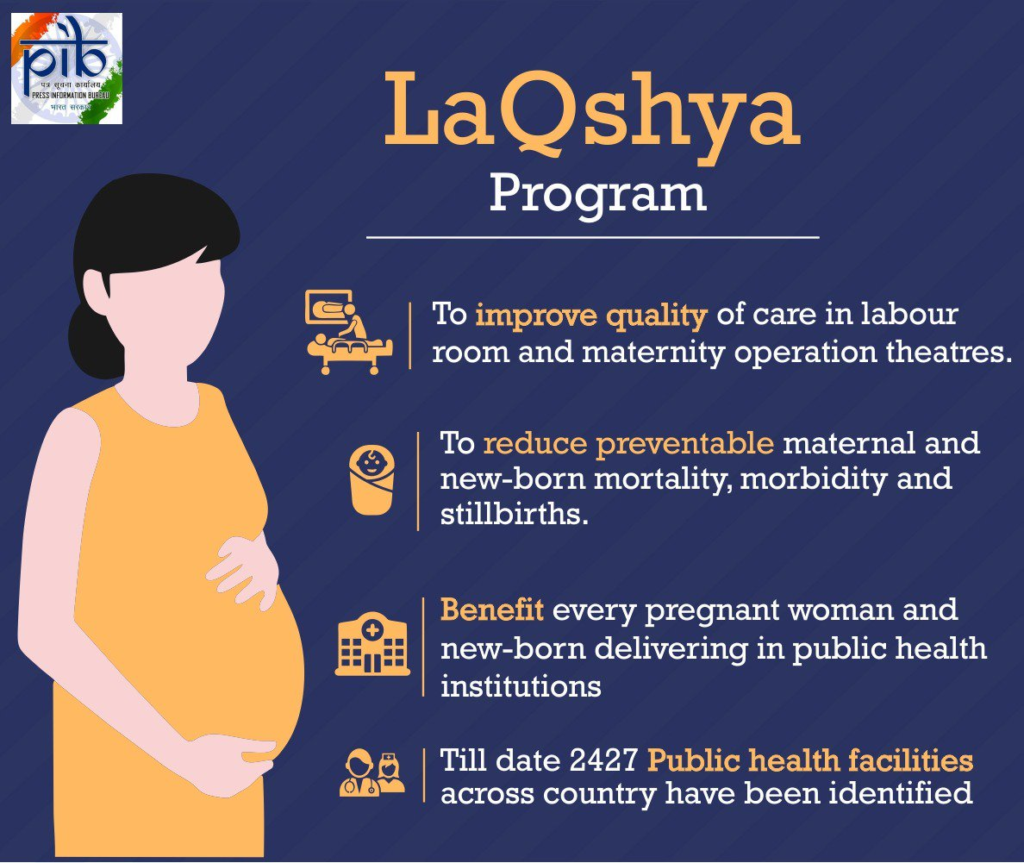
Introduction
The LaQshya program—short for Labour Room Quality Improvement Initiative—is a flagship initiative under the National Health Mission (NHM) by the Ministry of Health and Family Welfare (MoHFW), Government of India. Launched in 2017, its primary aim is to reduce preventable maternal and newborn mortality, morbidity, and stillbirths associated with the care around delivery in the Labour Room and Maternity Operation Theatre (OT), and to ensure respectful maternity care.
Objectives of LaQshya
- Reduce Preventable Maternal and Newborn Mortality and Morbidity:
- By enhancing the quality of care during childbirth, LaQshya seeks to minimize complications leading to maternal and neonatal deaths.
- Ensure Respectful Maternity Care (RMC):
- The program emphasizes the importance of treating every woman with dignity and respect during childbirth, aligning with global standards of RMC.
Implementation Strategy
LaQshya is implemented across various levels of public health facilities, including:
- Medical College Hospitals
- District Hospitals
- First Referral Units (FRUs)
- Community Health Centres (CHCs)
Key Components:
- Infrastructure Upgradation:
- Ensuring that labour rooms and maternity OTs are equipped with necessary infrastructure to provide quality care.
- Availability of Essential Equipment:
- Provision of essential medical equipment to handle obstetric emergencies and neonatal care.
- Adequate Human Resources: Deployment of trained healthcare professionals, including obstetricians, anesthetists, and nurses.
- Capacity Building of Healthcare Workers:
- Regular training and skill enhancement programs for healthcare providers to ensure adherence to standard protocols.
- Improving Quality Processes:
- Implementation of standardized procedures and checklists to maintain consistency in care delivery.
Quality Assurance through NQAS
The quality improvement in labour rooms and maternity OTs under LaQshya is assessed through the National Quality Assurance Standards (NQAS). Facilities are evaluated based on predefined criteria, and those achieving a score of 70% or above are recognized as LaQshya-certified.
Impact on Maternal Mortality Ratio (MMR)

India has made significant strides in reducing the Maternal Mortality Ratio (MMR). According to the Sample Registration System (SRS) data:
- 2011-13: MMR was 167 per 100,000 live births.
- 2014-16: MMR reduced to 130 per 100,000 live births.
- 2015-17: Further decline to 122 per 100,000 live births.
- 2016-18: MMR stood at 113 per 100,000 live births.
- 2018-20: Achieved an MMR of 97 per 100,000 live births.

This downward trend indicates the positive impact of initiatives like LaQshya in improving maternal health outcomes.
Promoting Respectful Maternity Care
LaQshya places a strong emphasis on Respectful Maternity Care (RMC), ensuring that women are treated with dignity, privacy, and empathy during childbirth. This approach not only enhances the birthing experience but also encourages more women to opt for institutional deliveries, thereby reducing the risks associated with home births.
Continuous Quality Improvement
To maintain and enhance the quality of care, LaQshya incorporates:
- Regular Assessments:
- Periodic evaluations using NQAS checklists to identify gaps and areas for improvement.
- Mentorship Programs:
- Experienced professionals mentor healthcare workers to adopt best practices.
- Feedback Mechanisms:
- Establishing channels for patients and staff to provide feedback, fostering a culture of continuous improvement.
Conclusion
The LaQshya program represents a significant step towards enhancing maternal and newborn care in India. By focusing on quality improvement, infrastructure development, and respectful care, LaQshya aims to ensure safe and dignified childbirth experiences for all women. The program’s comprehensive approach has already shown promising results in reducing maternal and neonatal mortality, aligning with India’s commitment to achieving the Sustainable Development Goals (SDGs) related to maternal health.



















